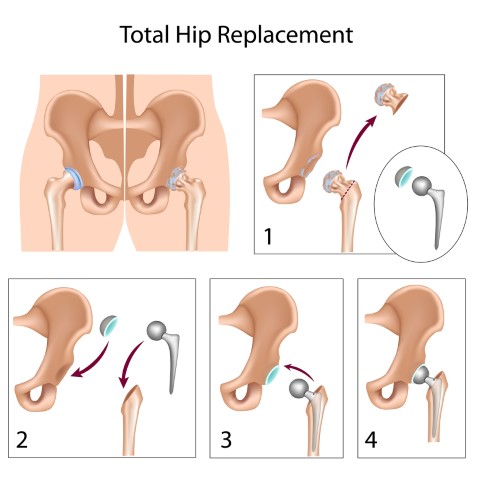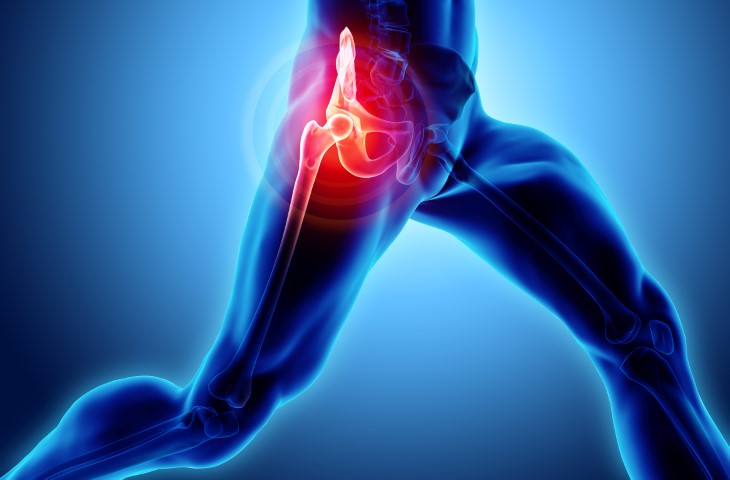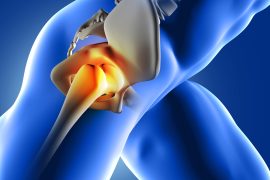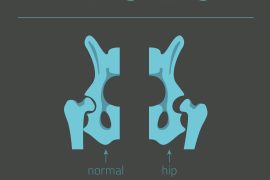Hip replacement is a surgical procedure in which a surgeon removes the damaged and painful sections of the hip joint and replaces it with an artificial one that is usually made from metal, ceramic, and High density plastic components. This procedure is undertaken to reduce pain and improve one’s joint movement and function. The artificial joint is known as a prosthesis.
Hip replacement is usually done when other, less invasive methods have failed to provide relief to the patient. Also known as Hip Arthroplasty, hip replacement is also considered if the hip pain interferes with one’s daily activities. Damage caused due to Arthritis is one of the most common reasons for Hip Replacement Surgery. Some conditions that may require hip replacement surgery to treat it are:
Osteoarthritis: Also known as wear-and-tear arthritis, this condition damages the protective cartilage that cushions the ends of your bones which helps the joints move smoothly.
Rheumatoid Arthritis: This is an autoimmune disease in which there is inflammation in the joints, which in turn leads to bone erosion and joint deformity.
Osteonecrosis: Osteonecrosis occurs when there is no adequate blood supply to the ball portion of the hip joint, which might occur due to dislocation of the hip bone or hip fracture.
Does an artificial hip work better after a hip replacement?



Hip replacement offers the greatest benefit of pain relief. Along with that, there is an improvement in movement, strength, and coordination of the lower body. It also helps you to get back to your active life. But, despite being highly effective, an artificial hip is associated with certain limitations.
1. Durability: Though majority the of the artificial hip implants last for 15 to 20 years, one cannot guarantee smooth functioning in every case of certain situations such as infections or trauma, an artificial hip can get worn out quickly, making it necessary for a second replacement. Normally, an artificial hip can work for up to 15 – 20 years, without any major trouble.
2. Susceptibility to allergy: Though these problems are rarely seen, they can occur. The patient may display signs of metal allergy after the surgery. This is characterized by skin rash, itching sensation, and discoloration in the area where the artificial joint has been fixed.
3. Weather problems: In some patients, the natural bones surrounding the hip implant take more time to adapt to the metallic nature of the hip, leading to increased weather sensitivity in the patient. Due to this phenomenon, a patient may feel increased pain and stiffness in the artificial hip in certain seasons like monsoon or winter.
4. Caution in future dental visits: You need to take care while visiting your dentist after your hip replacement as you could catch an infection. Preferably, you should take a prophylactic antibiotic.
What type of permanent restrictions will one have after a hip replacement surgery?
Every patient’s experience with Hip Replacement Surgery is not the same. Hence, it is not possible to predict whether a particular patient will have permanent movement restrictions after hip replacement or not. Most of the patients can return to a normal daily routine without any permanent restrictions, albeit with less pain and discomfort. However, a risk always prevails regarding an implant getting worn out, in which case the patient might need a second replacement. Though there are no permanent restrictions in most cases, there are certain activities one has to avoid for a certain period. These restrictions are also known as posterior hip precautions. They are:
- Cross your legs: One should not cross their legs past the midline of the body after a hip replacement surgery. To avoid crossing your legs, the surgeon may also advise sleeping on your side or keeping a pillow between the legs.
- Forward bending: It is also important to ensure that you do not bend your hip beyond 90 degrees after a hip replacement. Your knee must be below your hip joint. You can utilize cushions and pillows to elevate your seat, to ensure that your knees are positioned lower than your hips.
- Positioning your feet: Ensure that you keep your feet and your knees pointed straight ahead, in the front. Do not try turning them in or out. Also, avoid sitting in the same position for more than 30 – 40 minutes.
- Seating arrangement: Make sure that you are using a firm chair with a straight back and armrests. Avoid chairs that are too soft, rocking chairs, recliners, and stools.
- Climbing the stairs: Avoid climbing the stairs very frequently, as it will put a strain on the artificial joint.
Even after the joint has completely healed strenuous physical activities like sports must be avoided. It is important to keep in mind that the prosthetic joint has only been designed to withstand day-to-day physical activities. You can work with a physical therapist to learn various techniques and guidelines while performing various activities. If you do not follow the above-mentioned restrictions, you may run the risk of dislocating your joint, leading to second replacement surgery. Hence, you must be well-informed and take precautions with utmost care as suggested by your surgeon.





Comments are closed.